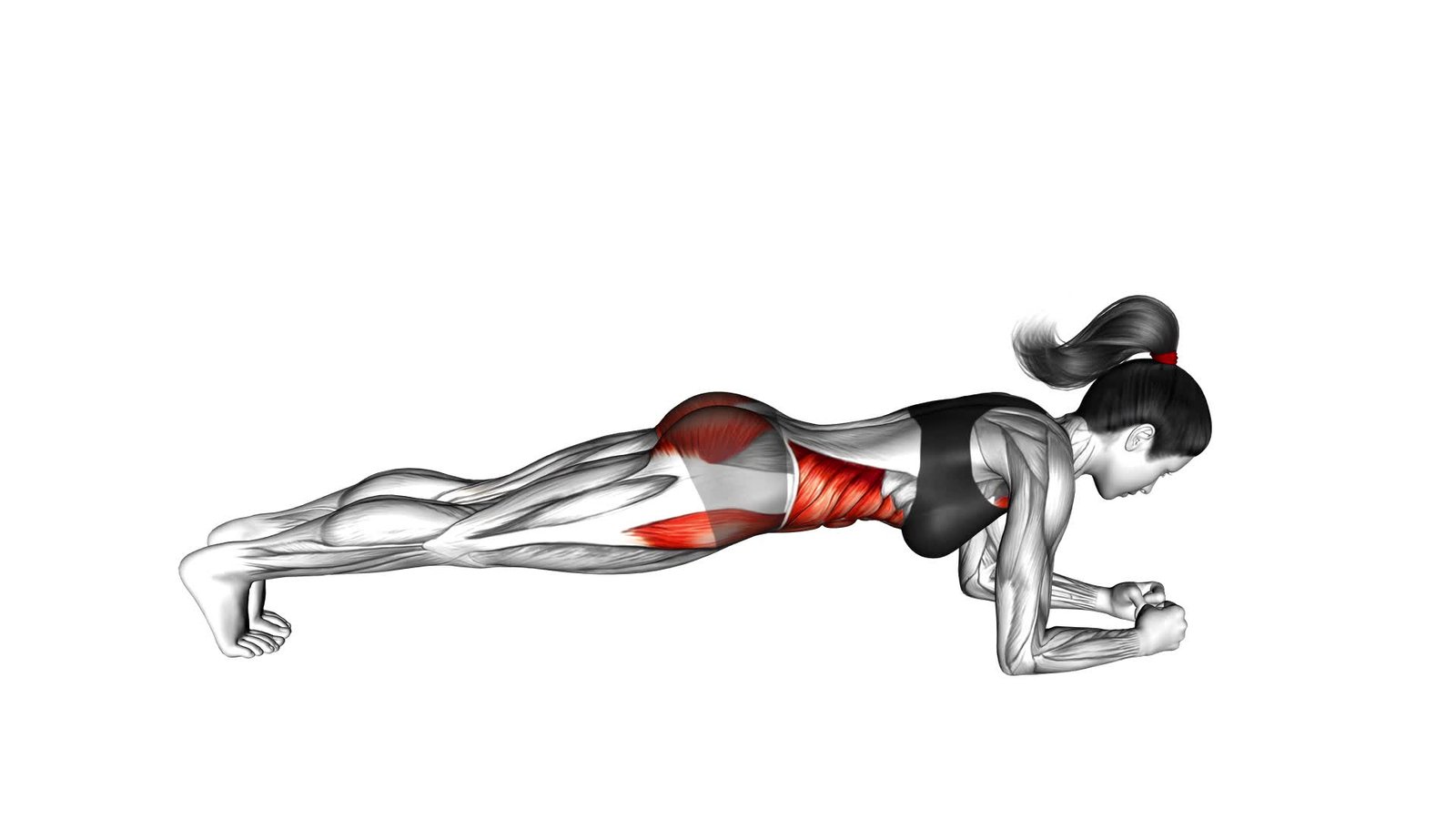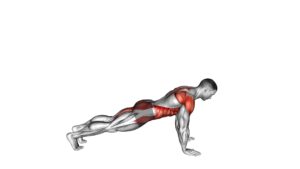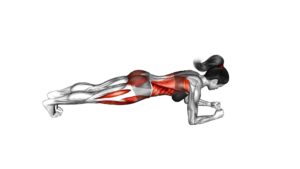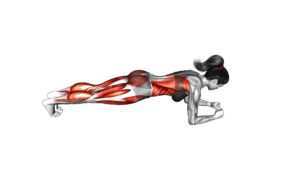Front Plank (female) – Video Exercise Guide & Tips

Looking to strengthen your core and improve your overall fitness? The front plank exercise is a great choice for you!
Watch This Exercise Video
In this video exercise guide, we'll show you proper form and technique specifically for females. Whether you're a beginner or looking for a greater challenge, we've got modifications and advanced variations to suit your needs.
Say goodbye to common mistakes and hello to progress with our helpful tips for increasing difficulty.
Get ready to plank like a pro!
Key Takeaways
- The front plank exercise improves core strength, stability, and posture.
- There are various plank variations that target different muscle groups.
- Proper form and technique involve maintaining alignment and engaging the core and glutes.
- Beginners can modify the exercise by starting on their knees or using unstable surfaces, while advanced variations add greater challenge.
Benefits of the Front Plank Exercise
You can achieve numerous benefits from performing the front plank exercise. One of the primary benefits is the improvement of core strength. The front plank targets your abdominal muscles, including the rectus abdominis, transverse abdominis, and obliques. By engaging these muscles, you can develop a stronger and more stable core, which is essential for maintaining proper posture and stability during daily activities and workouts.
Another benefit of the front plank exercise is its versatility. There are various front plank variations that you can incorporate into your routine to challenge different muscle groups and add variety to your workout. Some popular variations include the side plank, plank with leg lift, and plank with arm reach. These variations target not only your core but also your shoulders, glutes, and back muscles.
Furthermore, the front plank exercise can help improve your overall body strength and endurance. By holding the plank position for an extended period, you're engaging and strengthening multiple muscle groups simultaneously. This can lead to increased muscle definition, improved muscular endurance, and enhanced overall physical performance.
In conclusion, the front plank exercise offers a range of benefits, including improved core strength, versatility through various plank variations, and enhanced overall body strength and endurance. These benefits make the front plank an effective exercise for individuals of all fitness levels.
Now, let's move on to discussing the proper form and technique for performing the front plank exercise (female).
Proper Form and Technique for Front Plank (Female)
To perform the front plank exercise with proper form and technique, it's important to focus on alignment and posture.
Keep your body in a straight line from head to toe, engaging your core and squeezing your glutes.
Remember to breathe and avoid sagging or raising your hips.
Alignment and Posture Tips
Maintain proper alignment and posture during the front plank exercise by engaging your core and keeping your body in a straight line from head to toe. This is crucial for maximizing the effectiveness of the exercise and preventing injuries.
Here are four important alignment and posture tips to keep in mind:
- Keep your shoulders directly above your elbows to avoid straining your neck and upper back.
- Tighten your glutes and squeeze your thighs together to engage your lower body and maintain stability.
- Avoid sagging or arching your lower back by engaging your abdominal muscles and pulling your belly button toward your spine.
- Maintain a neutral head position by looking down at the floor, rather than lifting or dropping your head.
By following these alignment and posture tips, you'll ensure that you're performing the front plank exercise correctly and efficiently.
Now, let's move on to the next section about muscle engagement cues.
Muscle Engagement Cues
Engage your core muscles and maintain proper form and technique during the front plank exercise for optimal results.
To engage your muscles, start by positioning yourself face down on the floor with your forearms and toes touching the ground. Keep your elbows directly under your shoulders and your body in a straight line from head to toe.
As you lift your body off the ground, focus on activating your core muscles by drawing your belly button towards your spine. Avoid sagging your hips or arching your lower back.
Hold this position for the desired amount of time while maintaining proper form.
Common Mistakes to Avoid
When performing the front plank exercise, it's important to be aware of common mistakes that can compromise proper form and technique. To ensure you get the most out of this exercise and avoid potential injuries, here are four common mistakes to avoid:
- Dropping your hips: Proper form requires keeping your hips in line with your shoulders and ankles. Avoid letting your hips sag or lift too high, as this can strain your lower back.
- Holding your breath: Remember to breathe throughout the exercise. Holding your breath can increase tension and make it harder to maintain proper form.
- Allowing your shoulders to round: Keep your shoulders engaged and pulled back. Avoid rounding them forward, as this can put unnecessary stress on your neck and upper back.
- Focusing solely on time: Instead of just trying to hold the plank for a certain amount of time, prioritize maintaining proper form. Quality over quantity is key for getting the most benefits from this exercise.
Modifications for Beginners
To make the front plank exercise more accessible for beginners, you can start by using a modified version. This modification involves performing the plank on your knees instead of your toes. By doing this, you can still engage your core muscles and work on your stability without putting too much strain on your wrists and shoulders.
Another option for beginners is to start with a shorter duration for the front plank. Instead of holding the position for the recommended 30 to 60 seconds, you can begin with 10 to 20 seconds and gradually increase the time as you build strength and endurance.
For those who find the regular front plank challenging enough, there are also progression options available. One option is to lift one leg off the ground while maintaining the plank position. This will further engage your core and require more stability.
Modifications for front plank on unstable surfaces include performing the exercise on a stability ball or a foam pad. These unstable surfaces will challenge your stability even more, forcing your core muscles to work harder to maintain the plank position.
Advanced Variations for a Greater Challenge
To further challenge yourself in the front plank exercise, try incorporating advanced variations into your routine to intensify the workout. Here are four side plank variations that will help you improve your core strength and take your planks to the next level:
- Side Plank with Leg Lift: Start in a side plank position with your forearm on the ground and your body in a straight line. Lift your top leg up and hold for a few seconds before lowering it back down. Repeat on the other side.
- Side Plank with Hip Dip: Begin in a side plank position and slowly lower your hip towards the ground, then lift it back up to the starting position. Repeat on both sides.
- Side Plank with Knee Tuck: Assume a side plank position and bring your top knee towards your chest, then extend it back out. Repeat on each side.
- Side Plank with Arm Reach: Start in a side plank position and extend your top arm up towards the ceiling, then slowly lower it back down. Repeat on both sides.
Incorporating these side plank variations into your routine will challenge your core muscles even more and help you achieve greater strength and stability.
Now, let's move on to the next section and discuss common mistakes to avoid.
Common Mistakes to Avoid
To maximize the effectiveness of your front plank exercise, it's important to avoid common mistakes that can hinder your progress and potentially lead to injury. By being aware of these mistakes and taking steps to correct them, you can ensure that you're getting the most out of your workout and reducing the risk of any unwanted setbacks.
One common mistake to avoid is sagging or arching your back. It's important to maintain a straight line from your head to your heels, engaging your core muscles to support your body.
Another mistake is placing your hands too far forward or too close together. Your hands should be directly under your shoulders, providing a stable base of support.
Additionally, avoid letting your hips drop or rise too high. Your body should be in a straight line, with your hips in line with your shoulders and heels.
Another mistake to watch out for is holding your breath. Remember to breathe regularly and deeply throughout the exercise to maximize oxygen flow and prevent unnecessary tension.
To make the front plank exercise more effective, you can also try modifying it. One effective modification is to perform the exercise on an unstable surface, such as a stability ball or a BOSU ball. This adds an extra challenge to your core muscles and can help improve overall stability and balance.
Tips for Progressing and Increasing Difficulty
To continue improving your front plank exercise and challenging your muscles, there are several tips you can follow to progress and increase the difficulty:
- Increase the duration: Start by holding the front plank for 30 seconds and gradually increase the time as your core strength improves. Aim for a minute or longer to really challenge yourself.
- Elevate your feet: Place your feet on an elevated surface, such as a step or bench, to increase the intensity of the exercise. This will engage your core and upper body muscles even more.
- Add movement: Introduce variations to your front plank by incorporating movement. For example, you can perform plank jacks by jumping your feet wide apart and back together, or knee-to-elbow planks by bringing your knee towards your opposite elbow. These movements will increase the demand on your core muscles.
- Use unstable surfaces: Incorporate unstable surfaces like a stability ball or a Bosu ball to challenge your stability and engage more muscles. By performing the front plank on these surfaces, you'll need to work harder to maintain your balance.
Frequently Asked Questions
How Long Should I Hold the Front Plank Exercise?
To get the most out of the front plank exercise, it's important to know how long to hold it. The duration varies depending on your fitness level and goals. Initially, aim for 20-30 seconds and gradually increase the time as you get stronger.
Holding the plank for 1-2 minutes is a good goal to work towards. This exercise can help strengthen your core, improve posture, and enhance overall stability.
Can I Do the Front Plank Exercise Every Day?
Yes, you can do the front plank exercise every day. Doing the front plank variations regularly can provide numerous benefits. It helps strengthen your core muscles, improves stability, and enhances overall posture.
However, it's important to listen to your body and not overdo it. Start with a reasonable amount of time, gradually increasing the duration as you get stronger.
Remember to maintain proper form and engage your core muscles throughout the exercise for maximum effectiveness.
What Muscles Does the Front Plank Exercise Target?
The front plank exercise targets several key muscles in your body. It primarily works your core muscles, including the rectus abdominis, transverse abdominis, and obliques. These muscles help improve your overall core strength, stability, and posture.
Additionally, there are variations of the front plank exercise that you can try to challenge yourself even further. These variations include side planks, knee plank, and plank with leg lifts. Incorporating these variations into your routine can provide additional benefits for your core strength.
Are There Any Alternatives to the Front Plank Exercise?
Looking for alternative exercises or variations of the plank? There are several options you can try.
Instead of the front plank, you can do side planks, reverse planks, or even incorporate movements like mountain climbers or plank jacks.
These exercises target similar muscles and can help strengthen your core and improve stability.
Remember to listen to your body and choose exercises that work best for you.
Keep challenging yourself and have fun with your workouts!
How Can I Prevent Wrist Pain While Performing the Front Plank Exercise?
To prevent wrist pain during the front plank exercise, focus on wrist alignment by keeping your palms flat on the ground and your fingers spread wide. This helps distribute the weight evenly and reduces strain on your wrists.
You can also use props like push-up bars or yoga blocks to provide additional support and alleviate pressure on your wrists.
Remember to listen to your body and modify the exercise as needed to avoid discomfort.
Conclusion
In conclusion, the front plank exercise is a highly effective core strengthening exercise for females. It offers numerous benefits, including improved posture, increased core stability, and enhanced overall strength.
By maintaining proper form and technique, beginners can safely perform this exercise, while advanced variations provide a greater challenge for those seeking more intensity. Avoiding common mistakes and gradually progressing in difficulty will maximize results.
Incorporate the front plank into your fitness routine and reap the rewards of a stronger core.

Author
Years ago, the spark of my life’s passion ignited in my mind the moment I stepped into the local gym for the first time. The inaugural bead of perspiration, the initial endeavor, the very first surge of endorphins, and a sense of pride that washed over me post-workout marked the beginning of my deep-seated interest in strength sports, fitness, and sports nutrition. This very curiosity blossomed rapidly into a profound fascination, propelling me to earn a Master’s degree in Physical Education from the Academy of Physical Education in Krakow, followed by a Sports Manager diploma from the Jagiellonian University. My journey of growth led me to gain more specialized qualifications, such as being a certified personal trainer with a focus on sports dietetics, a lifeguard, and an instructor for wellness and corrective gymnastics. Theoretical knowledge paired seamlessly with practical experience, reinforcing my belief that the transformation of individuals under my guidance was also a reflection of my personal growth. This belief holds true even today. Each day, I strive to push the boundaries and explore new realms. These realms gently elevate me to greater heights. The unique combination of passion for my field and the continuous quest for growth fuels my drive to break new ground.



